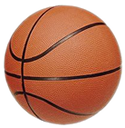Basketball Passing Drills – The Basics
Basketball Passing Drills and Basics are very important skills that players need to succeed in youth basketball. Poor passing and not catching the ball can lead to unforced turnovers and easy steals for your opponent. There are many different types of passes that players can use in the game of basketball – Bounce pass, Chest pass, Overhead pass, Step Around pass, Lead pass, and the Skip pass to name a few Passing and Catching Basics.
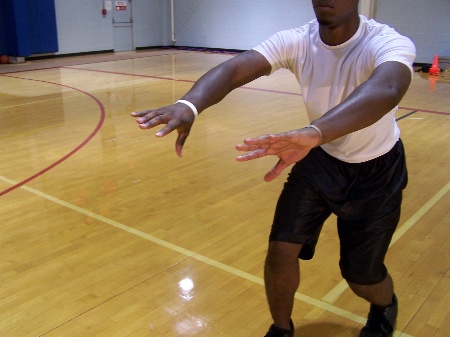 |
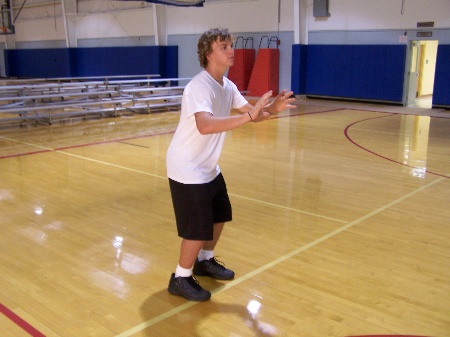 |
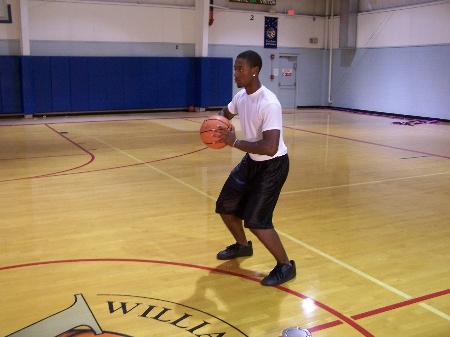 |
Principles of Passing the Basketball:
Passing the basketball is an “offensive” skill that requires lots of practice. Ensure that the players practice proper passing techniques / mechanics at all times.
a) Players should try to make the “shortest” pass, usually a coach will refer to this as “make the easiest” pass. The longer passes are not as accurate and tend to get “stolen” by the defense.
b) Players should pass the ball to the “receivers” hands (the target).
c) Teach your players to pass with their thumbs starting behind the ball and ending with their thumbs pointing downwards.
d) Players should always make “strong” passes, “soft” passes will get stolen or deflected by the defense.
e) When passing the ball, the pass should be thrown to the “opposite” side of the receivers defender (don’t make it easy for the defender to steal the pass).

The bottom line when practicing basketball passing drills is that every pass must be “strong” and “accurate” and players must be always be ready to catch the ball.
The Bounce Pass:
The bounce pass is thrown with two hands from the players’ chest area. The basic objective for the “bounce” pass is to pass the ball under the arms of a defender. The pass must be strong and accurate. Players should “bounce” the ball off the floor about 2/3 the way to the receiver (see diagram below). The ball should bounce into the receivers hands (waste level). 
The Chest Pass:
The chest pass is also thrown with two hands from the players chest area. The main reason it is called “chest” pass is because the ball is being passed from the passer’s chest area to the receiver’s chest area. A chest pass must be strong and accurate.
The Overhead Pass:
The overhead pass is used to pass to your teammates over defenders that are closely guarding or over smaller defenders (the overhead pass is not recommended if the defender is taller than you). The two handed overhead pass is used for close distances. The overhead pass is thrown using both hands from above the players head. The release of the ball is from behind the players head.
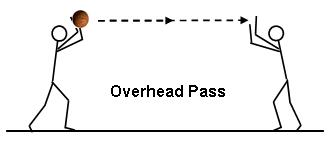
The Step Around Pass:
One of the best but seldom taught basketball passing drills is the “Step Around” pass. The step around pass is used to “step around” a defender that is closely guarding or for smaller players to get around taller defenders. From the triple threat position, the player takes their opposite foot and steps around the defender as they make a bounce pass. This pass must be done low, and with speed (remember, there is no “soft” passing allowed in basketball).
Check out our New Downloads Now!
The Skip Pass:
The skip pass is one of the basketball passing drills that is used on offense to pass the ball to the other side of the court – from the strong side of the court to the weak side of the court to an open shooter, or used to break the press. Many younger players do not have the strength to make a good skip pass, and when thrown too soft, this pass can turn into a fast break for your opponent (this pass must be used wisely).

The Lead Pass:
The lead pass is not an actual “pass” but rather considered a “step” used in all passes. Leading the player that is about to catch the basketball (putting the ball slightly ahead of the player so they don’t have to slow down or reach back for the ball) should be part of the pass. The Lead pass sounds easy, but it is very difficult for the younger players to grasp this technique. Younger players tend to pass the ball a little behind which can result in a steal or turnover. Below is a team drill that works on the lead pass. This pass (as with all passes) must be done low, and with speed (remember, there is no “soft” passing allowed in basketball).
Passing Mechanics:
Part of learning proper basketball passing drills is to ensure that your players learn and execute the fundamentals. Teach your players to pass with their thumbs starting behind the ball and ending with their thumbs pointing downwards – see pictures and video clip below. This is a very basic, but important skill to learn, coaches need to just “drill” it into your players until they are comfortable with it.
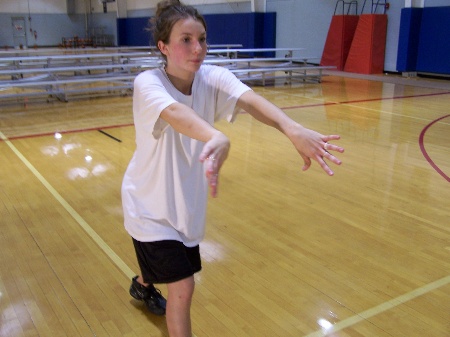
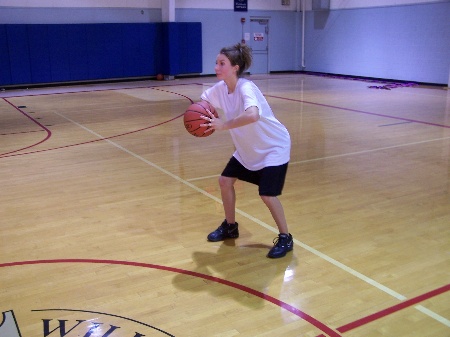
 Player steps towards the teammate they are passing to…
Player steps towards the teammate they are passing to… Thumbs are downward after the ball is released…
Thumbs are downward after the ball is released…
Catching the Basketball:
Good passes are canceled out if a player does not catch it!
There’s nothing worse than seeing a good pass canceled out just because another player did not catch it. This can cause lots of frustration within your team. I have seen players not pass the ball to an open player just because they felt they weren’t going to catch the ball – so why pass it to them? This is a problem that the coach needs to identify and fix before it gets out of control.
Principles of Catching the Basketball
a) The receiver must be ready to catch the ball by showing a “target” (have their hands up and ready to receive the ball at all times).
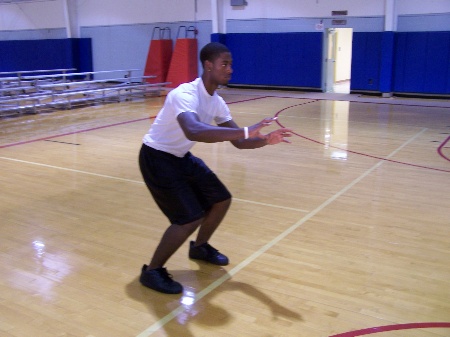
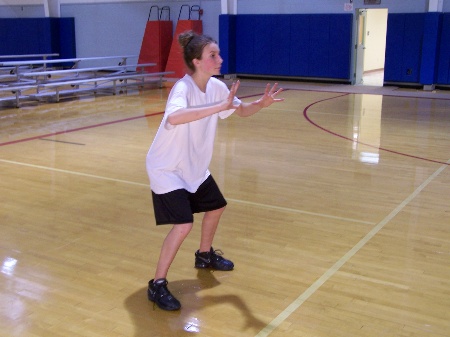
b) Players should not let the ball hit their body, they must always catch the ball with their hands.
c) Players must “look the ball” into their hands each and every time they catch the ball. The younger players tend to turn their heads when they are about to receive the pass.
d) When catching the ball a player must firmly grab and hold the ball – be strong when holding the basketball.
e) Players should “step” towards the ball to catch it, (never step backwards). Meet the pass, come to the pass, step to the pass!
Notes / Teaching Points:
1. Stress to the players that all passes should be “strong” and “accurate.” No “soft” passes allowed.
2. Passers should always find a target to pass to before passing (which is usually the receiver’s hands).
3. When getting ready to catch a pass, players should “look” the ball into their hands, and never lose eye contact with the ball. Coaches should demonstrate how the ball could hit a player in the nose or face when the player that is attempting to catch a pass takes their eye off the ball.
Soft Hands – This is the term used for players that are having trouble with the fundamental skill of catching (grasping) the basketball. Use this drill to help improve this players catching skills Power Slam – Drill for Soft Hands Handout and here is the Video Clip Power Slam / Drill for Soft Hands - Video Clip
4. Coaches should always ensure that the players are practicing the correct techniques / mechanics and not forming bad habits that will be hard to break later.
5. Keep the basketball passing drills interesting and fun! It’s always better when the players come to practices excited about the drills you are running. There are tons of passing drills available, but the one that helps the younger players the most is the “Weave” drill. It helps with catching, passing, coordination, accuracy, and coordination (plus it is a lot of fun for the players).
Weave Passing Drill / Basic Half Court
More Passing Drills – Video Clip Page
Passing and Catching skills can “make or break” a team.
How many times have you seen a good fast break end because the ball was passed over another players head, or how many times has your offense failed to work just because a player simply did not catch the ball. There are tons of examples of missed opportunities regarding passing and catching – but what can be done about it – here are some tips.
1. Make passing and catching drills a priority in your practice plan – if you don’t make your players better, nothing will change.
2. Identify the players with weak passing or catching skills, and try not to put them in a position where they can hurt the team. Most of all, explain to these players that they need to work extra hard on their passing / catching skills in order to help the team be successful (give them suggestions or homework to help them improve their skills).
3. Run game like situations in your practices. For example, if your point guard is having trouble feeding the ball into the post area, then make up a drill and go over it until the players are comfortable with it.
4. Make players run for passing a ball too “soft” or for not catching an easy pass.
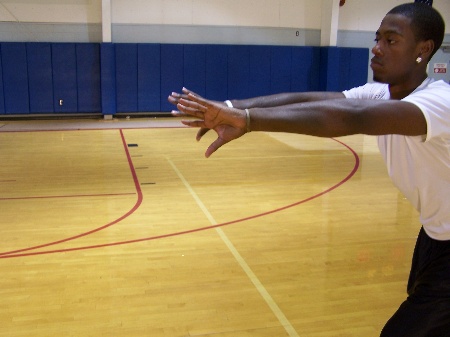
Basketball Passing Drills and Catching the Ball are one of the most important skill sets needed to play the game! A successful team makes strong and accurate passes, and always focuses on catching the ball. Coaches need to ensure that their players understand the fundamentals and mechanics of passing and catching. And then “drill” these fundamentals during practices. Don’t forget to check out our Passing Video Clips menu page – lots of passing / catching video clips.

